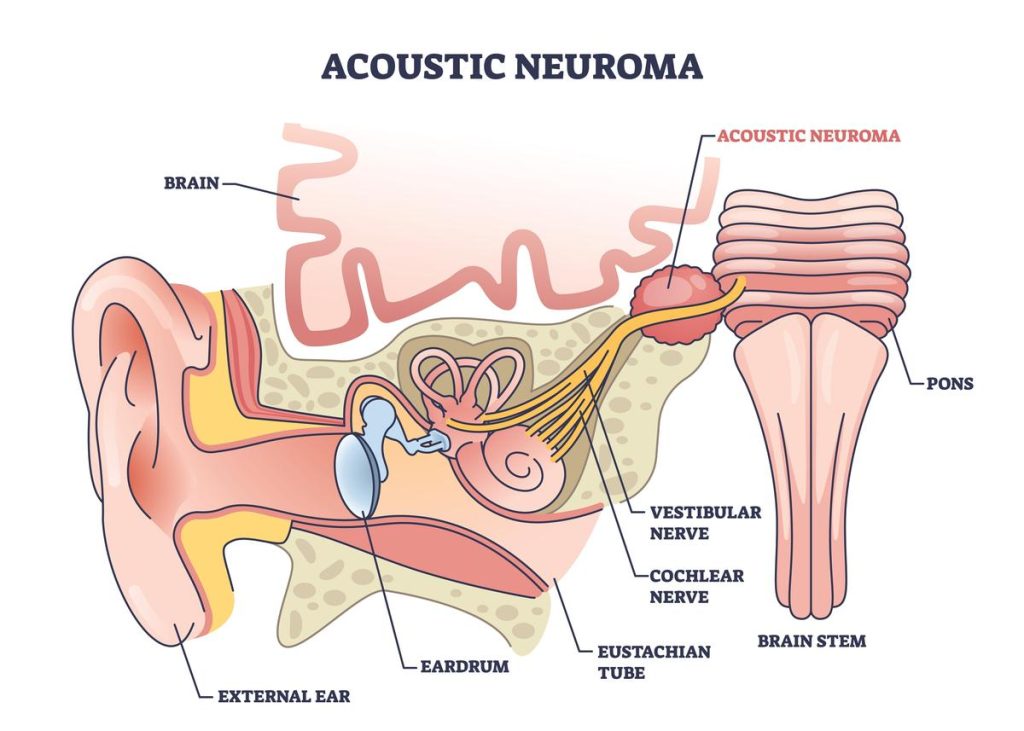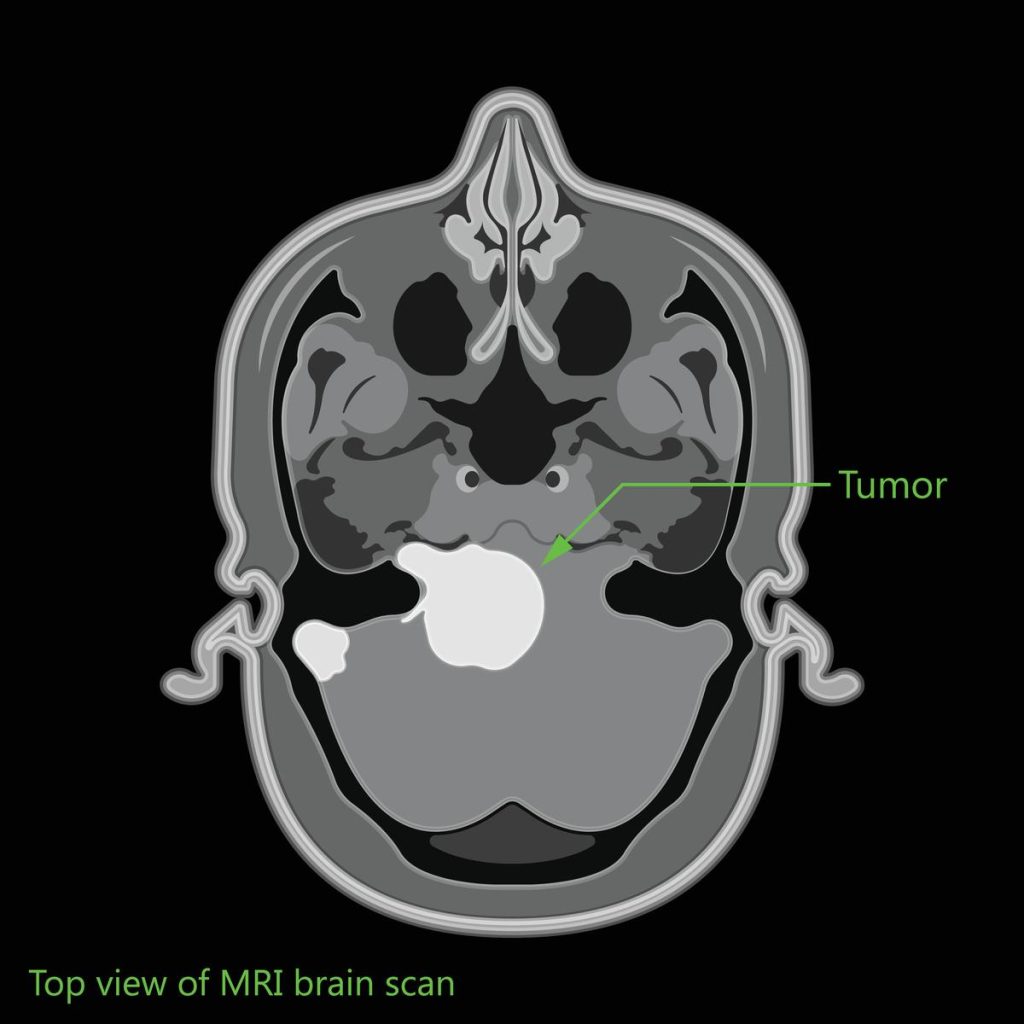Acoustic Neuroma
An acoustic neuroma, also known as a vestibular schwannoma, is a benign tumor that occurs in the inner ear.

This tumor primarily impacts a person’s ability to hear and maintain their balance. Available treatment options for this condition include monitoring the tumor’s progress, utilizing radiation therapy, or opting for surgery. Approximately half of individuals with small to medium-sized tumors, who had normal hearing prior to surgery, can still retain their hearing abilities after the procedure. In cases where hearing loss does occur, hearing devices can assist in improving auditory capabilities.
Who is a candidate?
If you possess the following conditions, you might qualify for suboccipital acoustic neuroma surgery:
- A considerable acoustic neuroma, either medium-sized or large, which is resulting in certain symptoms, primarily balance issues due to compression on the brainstem.
- Serviceable hearing in the affected ear
- Neurofibromatosis type 2 (NF-2)
Types of Acoustic Neuromas
In the realm of acoustic neuromas, there exist two distinct categories.
- Sporadic acoustic neuromas, which occur in 95% of patients, only grow on one side of the body. They are caused by sudden, nonhereditary mutations. These tumors can develop at any age, but are most frequently found in individuals between the ages of 30 and 60.
- People who have the genetic disorder neurofibromatosis type 2 develop acoustic neuromas on both sides of their body. This disorder is a result of a mutation in chromosome 22, which affects the gene responsible for producing Schwann cells. In addition to bilateral acoustic neuromas, these patients may also have other tumors similar to schwannomas throughout their body. The treatment for these tumors is often different from the treatment for unilateral tumors.
What are the symptoms of an acoustic neuroma?
Around 90% of individuals with an acoustic neuroma experience a specific symptom, which is the loss of hearing in just one ear (known as unilateral).
Additional signs and indications that might manifest during the initial phases comprise of:
- Ringing in the ears (tinnitus).
- Loss of balance.
- The feeling of either yourself or your surroundings being in motion (vertigo).

As the tumor enlarges, you might experience additional indicators, such as:
- Blurry or double vision.
- Loss of sensation, decreased strength, involuntary muscle contractions, discomfort, or inability to move muscles on the face.
- Taste changes.
- Headaches.
- Nausea and vomiting.
- Swallowing difficulty.
It can be difficult to diagnose an acoustic neuroma because its symptoms can be similar to other ear problems. If you experience any changes in your hearing, it is important to consult with your healthcare provider.
Acoustic neuroma diagnosis by rehabturk experts
An acoustic neuroma causes compression on nerves associated with hearing, equilibrium, and facial sensitivity. Numerous symptoms of this condition impact these specific areas.
- The loss of hearing in one ear can occur suddenly or gradually.
- The ear that is affected may experience ringing or a variety of other noises, known as tinnitus.
- Issues with equilibrium, such as feelings of lightheadedness
- Facial numbness and tingling
- Headaches
An otologist or neurotologist can diagnose an acoustic neuroma with the assistance of two tests.
- A contrast dye is injected through an IV during an MRI scan.
- A hearing test (audiogram)
Treatments for acoustic neuromas
Depending on factors such as the size and location of the tumor, its rate of growth, and your overall health, various treatment options are available for an acoustic neuroma.
The main options are:
- Keeping an eye on the growth of the tumor is important. In the case of small tumors, it is often enough to regularly examine them using MRI scans. Treatment is typically suggested only if the scans indicate that the tumor is increasing in size.
- Brain surgery is a medical procedure where a tumor is removed, either partially or entirely, by making an incision in the skull. This surgery is performed under general anesthesia, especially if the tumor is sizeable or showing signs of growth.
- Small tumors or any remaining fragments of a larger tumor after surgery can be effectively treated using stereotactic radiosurgery. This technique utilizes a highly accurate radiation beam to prevent these tumors from growing any further.

There are potential risks associated with all of these choices. For instance, both surgery and radiosurgery can occasionally result in facial numbness or paralysis.
Discuss with your expert regarding the most suitable choice for your needs and inquire about its advantages and potential drawbacks.
Recovery & prevention
You will need to book a second appointment with the neurosurgeon within 10 to 14 days following the surgery. The length of time it takes for you to recover will differ based on the size of the tumor and your overall health, usually ranging from 4 to 6 weeks. In most cases, patients can resume work after 6 weeks if their balance is improving, but it is important to confirm with your surgeon.
Is it possible to regain hearing after the removal of an acoustic neuroma?
Occasionally, hearing loss may occur due to the presence of a tumor or as a consequence of surgery. Unfortunately, in such situations, the ability to recover one’s hearing is typically not possible. However, your healthcare provider can offer solutions to alleviate the effects of hearing loss in one ear, which may involve recommending devices specifically designed to assist with this condition.
- The CROS aid is a device that looks similar to a microphone and is worn on both ears. Its purpose is to capture sound from the ear that can’t hear and transmit it to the ear that can hear.
- The bone conduction hearing implant is a device that is surgically attached to the skull behind the ear that does not have hearing capabilities. Its purpose is to transmit sound waves from the non-hearing ear to the ear that can hear.
- An auditory brainstem implant is a choice available for individuals diagnosed with neurofibromatosis. During the procedure, surgeons implant the device onto the auditory regions of the brain, leading to a partial restoration of hearing ability.
Treatment in Türkiye:
The medical staff of surgical teams, doctors and consultants in Rehab Türk can provide the best treatment options and free consultations – by striving to keep abreast of the latest medical technologies and methods.

